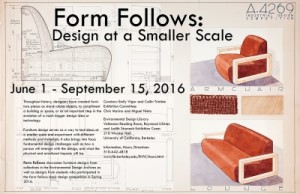S.T.E.A.M. for Grown-Ups:
Excavating the best practices amongst national movements that integrate the arts and S.T.E.M. field, this domain surfaces UC Berkeley’s own varied and deep, but as yet unclaimed, S.T.E.A.M. profile, plotting its future along the way.
- Go: October 27-28, 2016, Vision + Light: Extending the Senses as part of the Bay Area Science Festival
- Watch: Berkeley Lab’s first artist-in-residence, Kate Nichols transforms nanotechnology into creativity.
“Design” across Scales:
Given UC Berkeley’s historic strengths in art and design fields as well as recent innovations in engineering and business on campus, this domain considers the range of associations, practices, and values attached to “design” across a range of fields, assessing the strengths and weaknesses of design discourses and practices and plotting Berkeley’s potential to form cutting-edge collaborations.
- Go: Jacobs Design Conversations Series and Design Field Notes
- Go: Form Follows: Design at a Smaller Scale
Data Aesthetics:
On a campus where data science is being re-imagined within our core curriculum, this domain explores new innovations in data art, the aesthetics of data visualization, and the role of data in tracking arts participation, plotting new research fields and establishing role of the Arts and Design Initiative in cultivating numeracy in students and citizens.
- Learn: Digital Humanities Working Group
- Read: UC Berkeley staff and students kickoff of mission to rewrite the user interface for CollectionSpace, an open source, web-based museum collections management and information system
- Watch: Urban Data Visualization Project by UC Berkeley’s Smart Cities Research Center
Fabrication Across the Spectrum:
Whether in engineering or environmental design, in student groups or academic departments of art and theater, this team excavates the research labs and creative shops where faculty and students build, assemble, paint, wire, fire, and fabricate, identifying points of connection across units, seeding research collaborations, and imagining shared spaces and shared systems for the future.
- Learn: Critical Making
- Watch: Ronald Rael, “UNNATURAL: people, energy and materials in 3 acts.” Western thought conceptualizes nature and culture as distinct domains of anthropological understanding. However, as inhabitants of the Anthropocene, we (human kind) have significant influence on our planet’s ecosystem. Presently, nature is also culture. In three acts, Associate Professor of Architecture, Ronald Rael will discuss the back story of topics ranging from border walls, to solar technology, and 3D printing that, when filtered though the creative process of design, results in cultural projects he views as “unnatural”.






